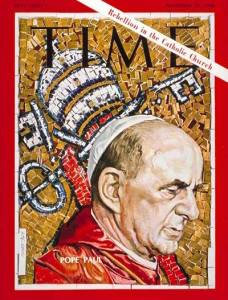In 1963, when I was a graduate student at St. Louis University, I was invited by a girlfriend to spend the Easter vacation with her family in the South. I accepted the invitation, and on our drive there the conversation turned to the Second Vatican Council, then under way, and the growing expectation that the Church’s teaching about contraceptives would change. My girlfriend was from a family of eleven children (almost all male, if I recall), and she mentioned the chagrin of her mother, who spoke about “all the sacrifices she had made” – sacrifices which new Church legislation might portray as unnecessary.
I survived the encounter with her “band of brothers,” and began to think about the possible changes regarding respect for Church authority, as well as the effect on morals, if her mother’s fears materialized.
But it seemed hardly possible that the laws of the Church regarding contraception could be changed, in view of the 1917 Canon Law operative in the 1960s, which stated clearly:
Canon 1013 §1. The primary end of marriage is the procreation and education of children; its secondary end is mutual help and the allaying of concupiscence.
Many theologians as well as some periti at Vatican II, however, had been arguing for some time that emphasis on “primary” procreative responsibilities connected with sacramental marriage caused diminishment of the “secondary” (unitive) aspects of marriage, and gave rise to a “hierarchical” view at odds with the anthropological essence of Christian marriage.
Discussion of the “Pastoral Constitution on the Church in the Modern World” (Gaudium et Spes) was then in its initial stages. The Preparatory Commission included a note that a “hierarchy of ends” should not in any way be suggested in the final document. And indeed, Gaudium et Spes managed to avoid any hierarchical pronouncement by including the following passage:
While not making the other purposes of matrimony of less account, the true practice of conjugal love, and the whole meaning of the family life which results from it, have this aim: that the couple be ready with stout hearts to cooperate with the love of the Creator and the Savior. Who through them will enlarge and enrich His own family day by day.
The phrase, “while not making the other purposes of matrimony of less account,” could be understood as removing the primary/secondary distinction, and, in the minds of many, as placing new emphasis on the unitive aspects of marriage. Clarifications would have to be forthcoming.
Many Council progressives supported conciliarism and episcopal collegiality. And Pope Paul, who shared the progressive ideal of overcoming the stereotype of papal autocracy (perceived as an obstacle to ecumenical reunion with other Christians), was interested, if possible, in bringing out a formulation of the issues consonant with input from the Episcopal College.
But his 1968 Encyclical Letter, Humanae vitae, contained a possible ambiguity regarding the procreative nature of the marital act in the following paragraph:
This particular doctrine, often expounded by the magisterium of the Church, is based on the inseparable connection, established by God, which man on his own initiative may not break, between the unitive significance and the procreative significance which are both inherent to the marriage act.
The pope here concentrates on the “significance” (or “meaning,” in some translations), rather than the procreative and unitive “purposes.” The two meanings could be considered of equal importance, with procreation enjoying no special preeminence. And in the atmosphere of the 1960s, languishing under the myth of overpopulation, even this diplomatic reformulation caused consternation.
Widespread dissent ensued. Hundreds of theologians published a full-page protest in The New York Times, and were supported by many bishops and priests. The procreative “purpose” no longer had any primacy. And the 1983 revised Code of Canon Law avoided any type of “hierarchical” language:
1055 §1. The marriage covenant, by which a man and a woman establish themselves a partnership of their whole life, and which of its own very nature is ordered to the well-being of the spouses and the procreation and upbringing of children, has, between the baptized, been raised by Christ the Lord to the dignity of a sacrament.
Recent popes have tried to prevent misunderstandings regarding procreation. In a 1984 General Audience, referring to Humanae vitae, Pope John Paul insisted: “The Church teaches as absolutely required that in any use whatever of marriage there must be no impairment of its natural capacity to procreate human life.” At the recent World Meeting of Families in Philadelphia, Pope Francis emphasized “the covenant of man and woman, which generates life and reveals God!”
But as I mentioned in a previous column, the “demotion” of “primary end” and the subsequent emphasis on “unitive” aspects of marriage, has even led some priests to consecrate intentionally childless marriages. More recently, this de-emphasis on procreation in favor of “the unitive significance” has certainly facilitated the slide towards obviously non-procreative “marriage” between homosexuals.
Whether or not the new language in Pope Paul’s encyclical and the 1983 Code of Canon Law amount to an official de-emphasis on the procreative purpose of marriage, the widespread use of contraceptives by Catholics points to a de facto de-emphasis.
This is a specter that overshadows the current Synod on the Family, and its discussion of remarried divorcees. For if it is presumed that Catholics were consistently using contraceptives in their first marriages, there may be reasonable doubt that they had the “openness to procreation” required for validity of marriage in the first place.
At Vatican II, because of the charged atmosphere and media reports, many were expecting a major pastoral change regarding the licitness of contraception. At the current Synod, widespread contraceptive use has impugned the character of “sacramental” marriages.















